101331 - Issues in World Development: Rich World, Poor World Essay
VerifiedAdded on 2023/06/13
|6
|1532
|142
Essay
AI Summary
This essay addresses issues in world development, focusing on the disparity between wealthy and developing nations. It summarizes how advanced Western economies achieved long-term development through industrial progress, technological advancements, and strategic adoption of capitalism. The essay also discusses the 'Closing the Gap' report and its utilization of the capability approach to improve the quality of life for Aboriginal and Torres Strait Islander people. Furthermore, it evaluates statements related to foreign direct investment, GDP as an indicator of progress, the impact of imperialism on Sub-Saharan Africa, dependency theory, and the structural transformation from agriculture to industry. The analysis incorporates various economic theories and real-world examples to provide a comprehensive overview of the challenges and opportunities in global development.
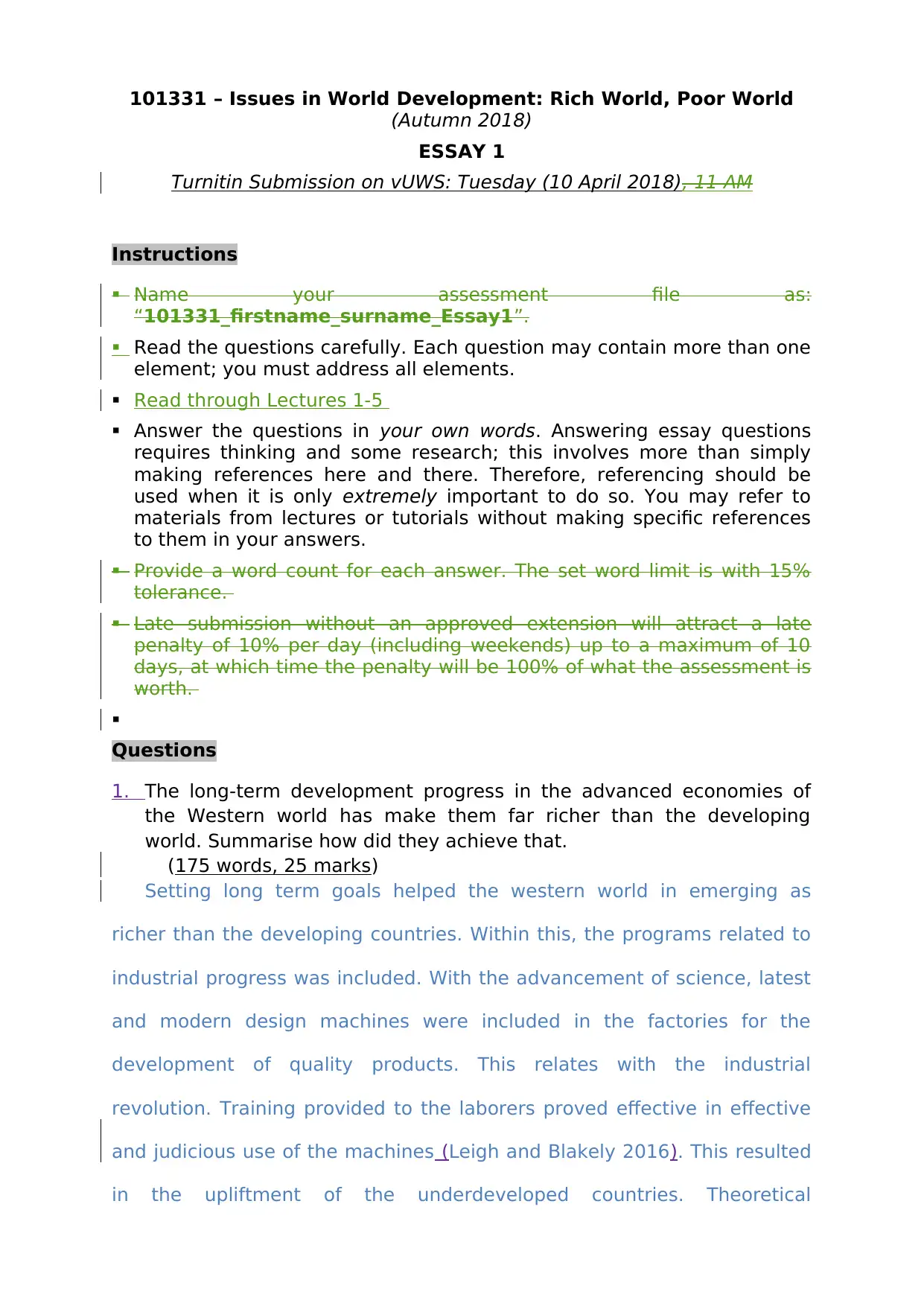
101331 – Issues in World Development: Rich World, Poor World
(Autumn 2018)
ESSAY 1
Turnitin Submission on vUWS: Tuesday (10 April 2018), 11 AM
Instructions
Name your assessment file as:
“101331_firstname_surname_Essay1”.
Read the questions carefully. Each question may contain more than one
element; you must address all elements.
Read through Lectures 1-5
Answer the questions in your own words. Answering essay questions
requires thinking and some research; this involves more than simply
making references here and there. Therefore, referencing should be
used when it is only extremely important to do so. You may refer to
materials from lectures or tutorials without making specific references
to them in your answers.
Provide a word count for each answer. The set word limit is with 15%
tolerance.
Late submission without an approved extension will attract a late
penalty of 10% per day (including weekends) up to a maximum of 10
days, at which time the penalty will be 100% of what the assessment is
worth.
Questions
1. The long-term development progress in the advanced economies of
the Western world has make them far richer than the developing
world. Summarise how did they achieve that.
(175 words, 25 marks)
Setting long term goals helped the western world in emerging as
richer than the developing countries. Within this, the programs related to
industrial progress was included. With the advancement of science, latest
and modern design machines were included in the factories for the
development of quality products. This relates with the industrial
revolution. Training provided to the laborers proved effective in effective
and judicious use of the machines (Leigh and Blakely 2016). This resulted
in the upliftment of the underdeveloped countries. Theoretical
(Autumn 2018)
ESSAY 1
Turnitin Submission on vUWS: Tuesday (10 April 2018), 11 AM
Instructions
Name your assessment file as:
“101331_firstname_surname_Essay1”.
Read the questions carefully. Each question may contain more than one
element; you must address all elements.
Read through Lectures 1-5
Answer the questions in your own words. Answering essay questions
requires thinking and some research; this involves more than simply
making references here and there. Therefore, referencing should be
used when it is only extremely important to do so. You may refer to
materials from lectures or tutorials without making specific references
to them in your answers.
Provide a word count for each answer. The set word limit is with 15%
tolerance.
Late submission without an approved extension will attract a late
penalty of 10% per day (including weekends) up to a maximum of 10
days, at which time the penalty will be 100% of what the assessment is
worth.
Questions
1. The long-term development progress in the advanced economies of
the Western world has make them far richer than the developing
world. Summarise how did they achieve that.
(175 words, 25 marks)
Setting long term goals helped the western world in emerging as
richer than the developing countries. Within this, the programs related to
industrial progress was included. With the advancement of science, latest
and modern design machines were included in the factories for the
development of quality products. This relates with the industrial
revolution. Training provided to the laborers proved effective in effective
and judicious use of the machines (Leigh and Blakely 2016). This resulted
in the upliftment of the underdeveloped countries. Theoretical
Paraphrase This Document
Need a fresh take? Get an instant paraphrase of this document with our AI Paraphraser
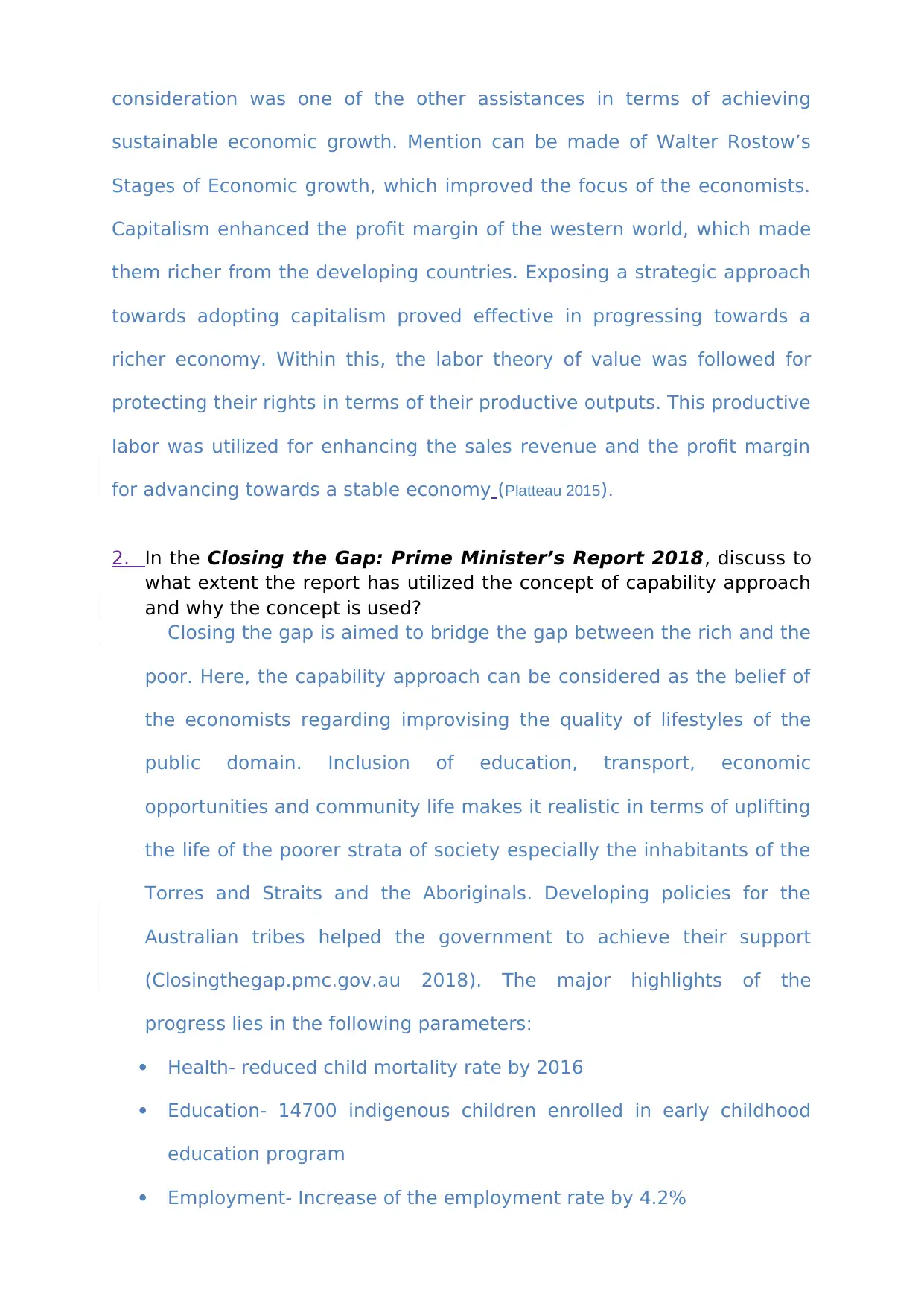
consideration was one of the other assistances in terms of achieving
sustainable economic growth. Mention can be made of Walter Rostow’s
Stages of Economic growth, which improved the focus of the economists.
Capitalism enhanced the profit margin of the western world, which made
them richer from the developing countries. Exposing a strategic approach
towards adopting capitalism proved effective in progressing towards a
richer economy. Within this, the labor theory of value was followed for
protecting their rights in terms of their productive outputs. This productive
labor was utilized for enhancing the sales revenue and the profit margin
for advancing towards a stable economy (Platteau 2015).
2. In the Closing the Gap: Prime Minister’s Report 2018, discuss to
what extent the report has utilized the concept of capability approach
and why the concept is used?
Closing the gap is aimed to bridge the gap between the rich and the
poor. Here, the capability approach can be considered as the belief of
the economists regarding improvising the quality of lifestyles of the
public domain. Inclusion of education, transport, economic
opportunities and community life makes it realistic in terms of uplifting
the life of the poorer strata of society especially the inhabitants of the
Torres and Straits and the Aboriginals. Developing policies for the
Australian tribes helped the government to achieve their support
(Closingthegap.pmc.gov.au 2018). The major highlights of the
progress lies in the following parameters:
Health- reduced child mortality rate by 2016
Education- 14700 indigenous children enrolled in early childhood
education program
Employment- Increase of the employment rate by 4.2%
sustainable economic growth. Mention can be made of Walter Rostow’s
Stages of Economic growth, which improved the focus of the economists.
Capitalism enhanced the profit margin of the western world, which made
them richer from the developing countries. Exposing a strategic approach
towards adopting capitalism proved effective in progressing towards a
richer economy. Within this, the labor theory of value was followed for
protecting their rights in terms of their productive outputs. This productive
labor was utilized for enhancing the sales revenue and the profit margin
for advancing towards a stable economy (Platteau 2015).
2. In the Closing the Gap: Prime Minister’s Report 2018, discuss to
what extent the report has utilized the concept of capability approach
and why the concept is used?
Closing the gap is aimed to bridge the gap between the rich and the
poor. Here, the capability approach can be considered as the belief of
the economists regarding improvising the quality of lifestyles of the
public domain. Inclusion of education, transport, economic
opportunities and community life makes it realistic in terms of uplifting
the life of the poorer strata of society especially the inhabitants of the
Torres and Straits and the Aboriginals. Developing policies for the
Australian tribes helped the government to achieve their support
(Closingthegap.pmc.gov.au 2018). The major highlights of the
progress lies in the following parameters:
Health- reduced child mortality rate by 2016
Education- 14700 indigenous children enrolled in early childhood
education program
Employment- Increase of the employment rate by 4.2%
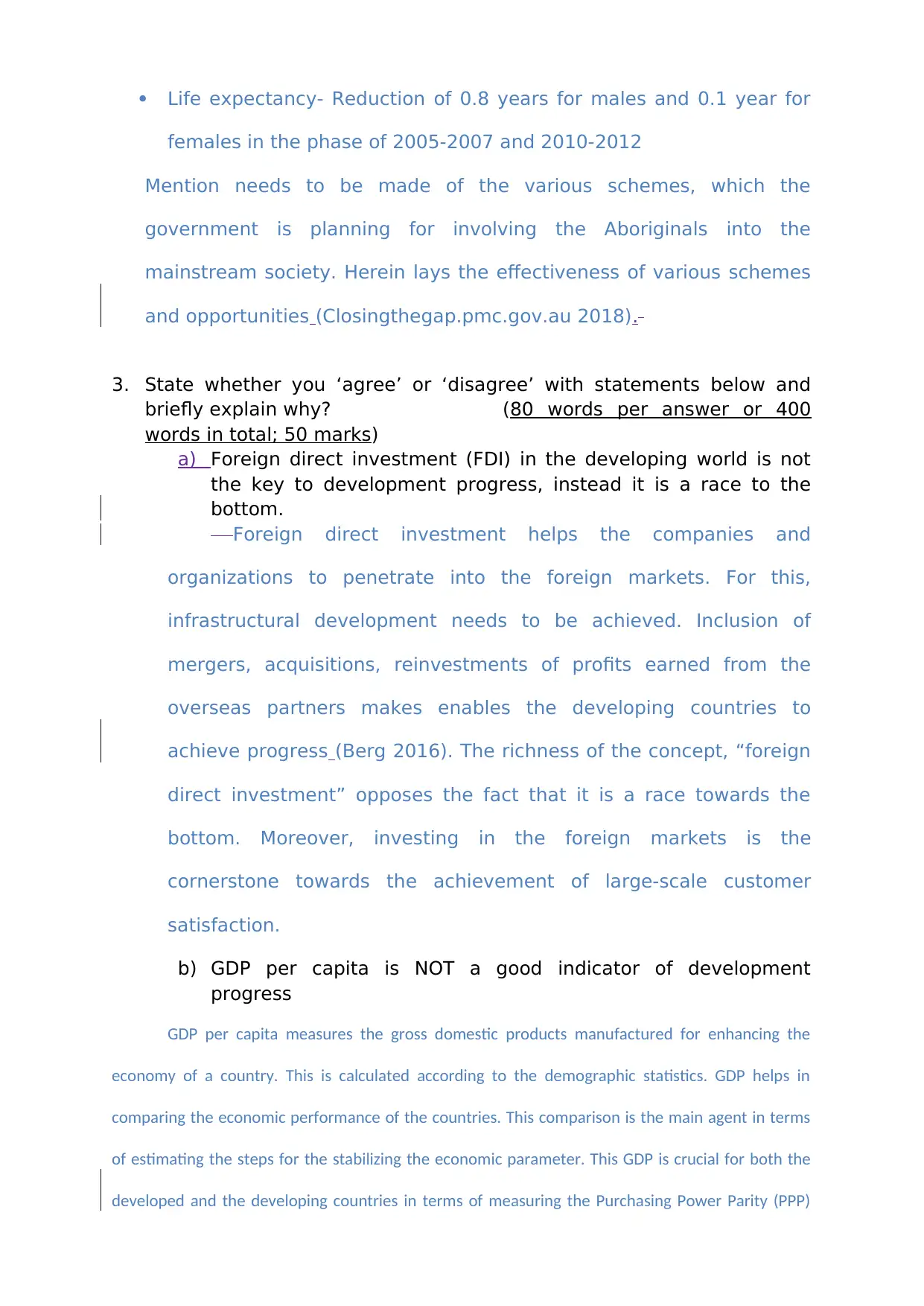
Life expectancy- Reduction of 0.8 years for males and 0.1 year for
females in the phase of 2005-2007 and 2010-2012
Mention needs to be made of the various schemes, which the
government is planning for involving the Aboriginals into the
mainstream society. Herein lays the effectiveness of various schemes
and opportunities (Closingthegap.pmc.gov.au 2018).
3. State whether you ‘agree’ or ‘disagree’ with statements below and
briefly explain why? (80 words per answer or 400
words in total; 50 marks)
a) Foreign direct investment (FDI) in the developing world is not
the key to development progress, instead it is a race to the
bottom.
Foreign direct investment helps the companies and
organizations to penetrate into the foreign markets. For this,
infrastructural development needs to be achieved. Inclusion of
mergers, acquisitions, reinvestments of profits earned from the
overseas partners makes enables the developing countries to
achieve progress (Berg 2016). The richness of the concept, “foreign
direct investment” opposes the fact that it is a race towards the
bottom. Moreover, investing in the foreign markets is the
cornerstone towards the achievement of large-scale customer
satisfaction.
b) GDP per capita is NOT a good indicator of development
progress
GDP per capita measures the gross domestic products manufactured for enhancing the
economy of a country. This is calculated according to the demographic statistics. GDP helps in
comparing the economic performance of the countries. This comparison is the main agent in terms
of estimating the steps for the stabilizing the economic parameter. This GDP is crucial for both the
developed and the developing countries in terms of measuring the Purchasing Power Parity (PPP)
females in the phase of 2005-2007 and 2010-2012
Mention needs to be made of the various schemes, which the
government is planning for involving the Aboriginals into the
mainstream society. Herein lays the effectiveness of various schemes
and opportunities (Closingthegap.pmc.gov.au 2018).
3. State whether you ‘agree’ or ‘disagree’ with statements below and
briefly explain why? (80 words per answer or 400
words in total; 50 marks)
a) Foreign direct investment (FDI) in the developing world is not
the key to development progress, instead it is a race to the
bottom.
Foreign direct investment helps the companies and
organizations to penetrate into the foreign markets. For this,
infrastructural development needs to be achieved. Inclusion of
mergers, acquisitions, reinvestments of profits earned from the
overseas partners makes enables the developing countries to
achieve progress (Berg 2016). The richness of the concept, “foreign
direct investment” opposes the fact that it is a race towards the
bottom. Moreover, investing in the foreign markets is the
cornerstone towards the achievement of large-scale customer
satisfaction.
b) GDP per capita is NOT a good indicator of development
progress
GDP per capita measures the gross domestic products manufactured for enhancing the
economy of a country. This is calculated according to the demographic statistics. GDP helps in
comparing the economic performance of the countries. This comparison is the main agent in terms
of estimating the steps for the stabilizing the economic parameter. This GDP is crucial for both the
developed and the developing countries in terms of measuring the Purchasing Power Parity (PPP)
⊘ This is a preview!⊘
Do you want full access?
Subscribe today to unlock all pages.

Trusted by 1+ million students worldwide
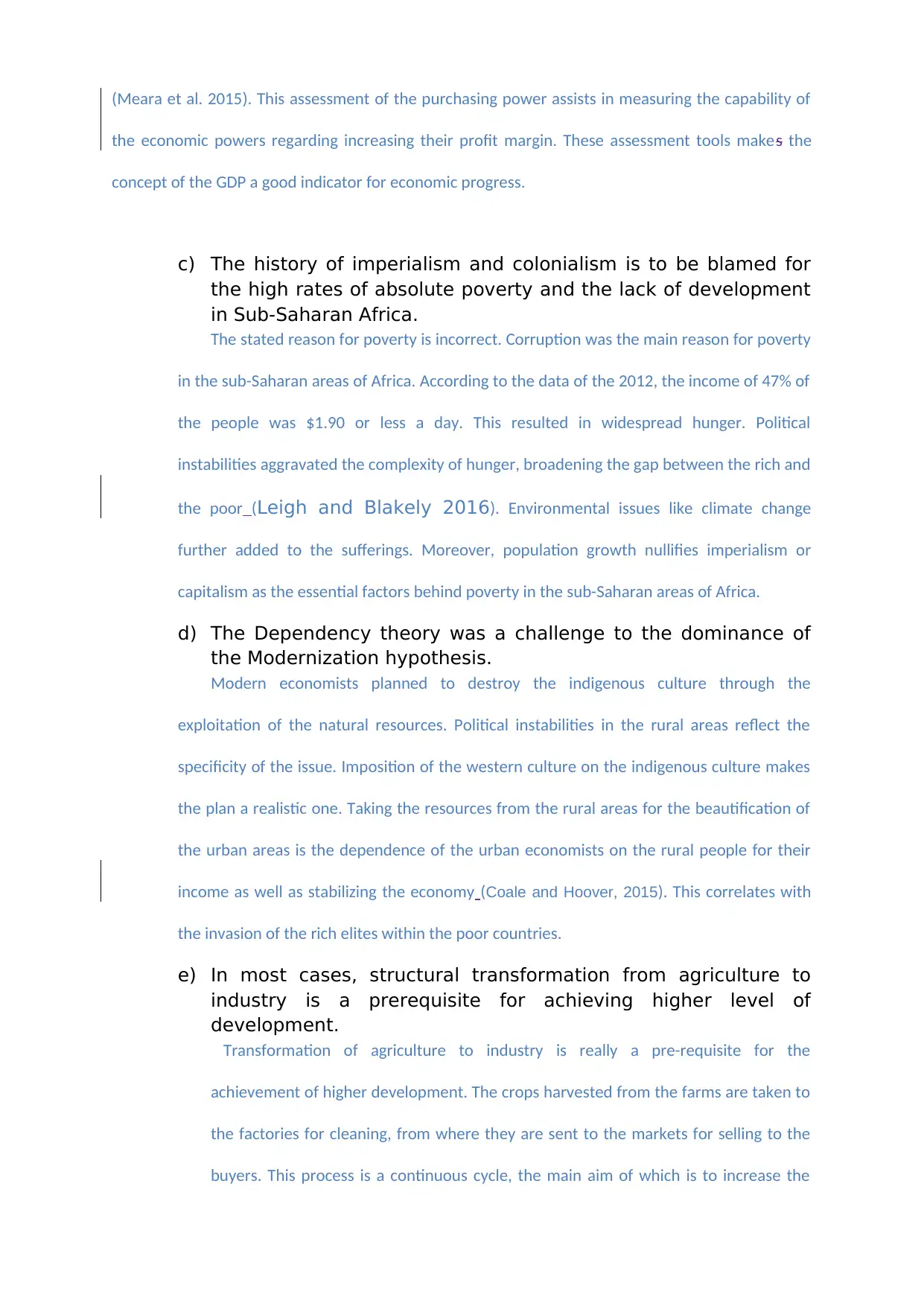
(Meara et al. 2015). This assessment of the purchasing power assists in measuring the capability of
the economic powers regarding increasing their profit margin. These assessment tools makes the
concept of the GDP a good indicator for economic progress.
c) The history of imperialism and colonialism is to be blamed for
the high rates of absolute poverty and the lack of development
in Sub-Saharan Africa.
The stated reason for poverty is incorrect. Corruption was the main reason for poverty
in the sub-Saharan areas of Africa. According to the data of the 2012, the income of 47% of
the people was $1.90 or less a day. This resulted in widespread hunger. Political
instabilities aggravated the complexity of hunger, broadening the gap between the rich and
the poor (Leigh and Blakely 2016). Environmental issues like climate change
further added to the sufferings. Moreover, population growth nullifies imperialism or
capitalism as the essential factors behind poverty in the sub-Saharan areas of Africa.
d) The Dependency theory was a challenge to the dominance of
the Modernization hypothesis.
Modern economists planned to destroy the indigenous culture through the
exploitation of the natural resources. Political instabilities in the rural areas reflect the
specificity of the issue. Imposition of the western culture on the indigenous culture makes
the plan a realistic one. Taking the resources from the rural areas for the beautification of
the urban areas is the dependence of the urban economists on the rural people for their
income as well as stabilizing the economy (Coale and Hoover, 2015). This correlates with
the invasion of the rich elites within the poor countries.
e) In most cases, structural transformation from agriculture to
industry is a prerequisite for achieving higher level of
development.
Transformation of agriculture to industry is really a pre-requisite for the
achievement of higher development. The crops harvested from the farms are taken to
the factories for cleaning, from where they are sent to the markets for selling to the
buyers. This process is a continuous cycle, the main aim of which is to increase the
the economic powers regarding increasing their profit margin. These assessment tools makes the
concept of the GDP a good indicator for economic progress.
c) The history of imperialism and colonialism is to be blamed for
the high rates of absolute poverty and the lack of development
in Sub-Saharan Africa.
The stated reason for poverty is incorrect. Corruption was the main reason for poverty
in the sub-Saharan areas of Africa. According to the data of the 2012, the income of 47% of
the people was $1.90 or less a day. This resulted in widespread hunger. Political
instabilities aggravated the complexity of hunger, broadening the gap between the rich and
the poor (Leigh and Blakely 2016). Environmental issues like climate change
further added to the sufferings. Moreover, population growth nullifies imperialism or
capitalism as the essential factors behind poverty in the sub-Saharan areas of Africa.
d) The Dependency theory was a challenge to the dominance of
the Modernization hypothesis.
Modern economists planned to destroy the indigenous culture through the
exploitation of the natural resources. Political instabilities in the rural areas reflect the
specificity of the issue. Imposition of the western culture on the indigenous culture makes
the plan a realistic one. Taking the resources from the rural areas for the beautification of
the urban areas is the dependence of the urban economists on the rural people for their
income as well as stabilizing the economy (Coale and Hoover, 2015). This correlates with
the invasion of the rich elites within the poor countries.
e) In most cases, structural transformation from agriculture to
industry is a prerequisite for achieving higher level of
development.
Transformation of agriculture to industry is really a pre-requisite for the
achievement of higher development. The crops harvested from the farms are taken to
the factories for cleaning, from where they are sent to the markets for selling to the
buyers. This process is a continuous cycle, the main aim of which is to increase the
Paraphrase This Document
Need a fresh take? Get an instant paraphrase of this document with our AI Paraphraser

sales revenue and gain profit from the buyers. Stable economy helps the marketers to
secure their position within the competitive market. Maintenance of this stability is
the agent towards penetrating into the foreign markets for expanding the scope and
area of business (Berg 2016).
secure their position within the competitive market. Maintenance of this stability is
the agent towards penetrating into the foreign markets for expanding the scope and
area of business (Berg 2016).
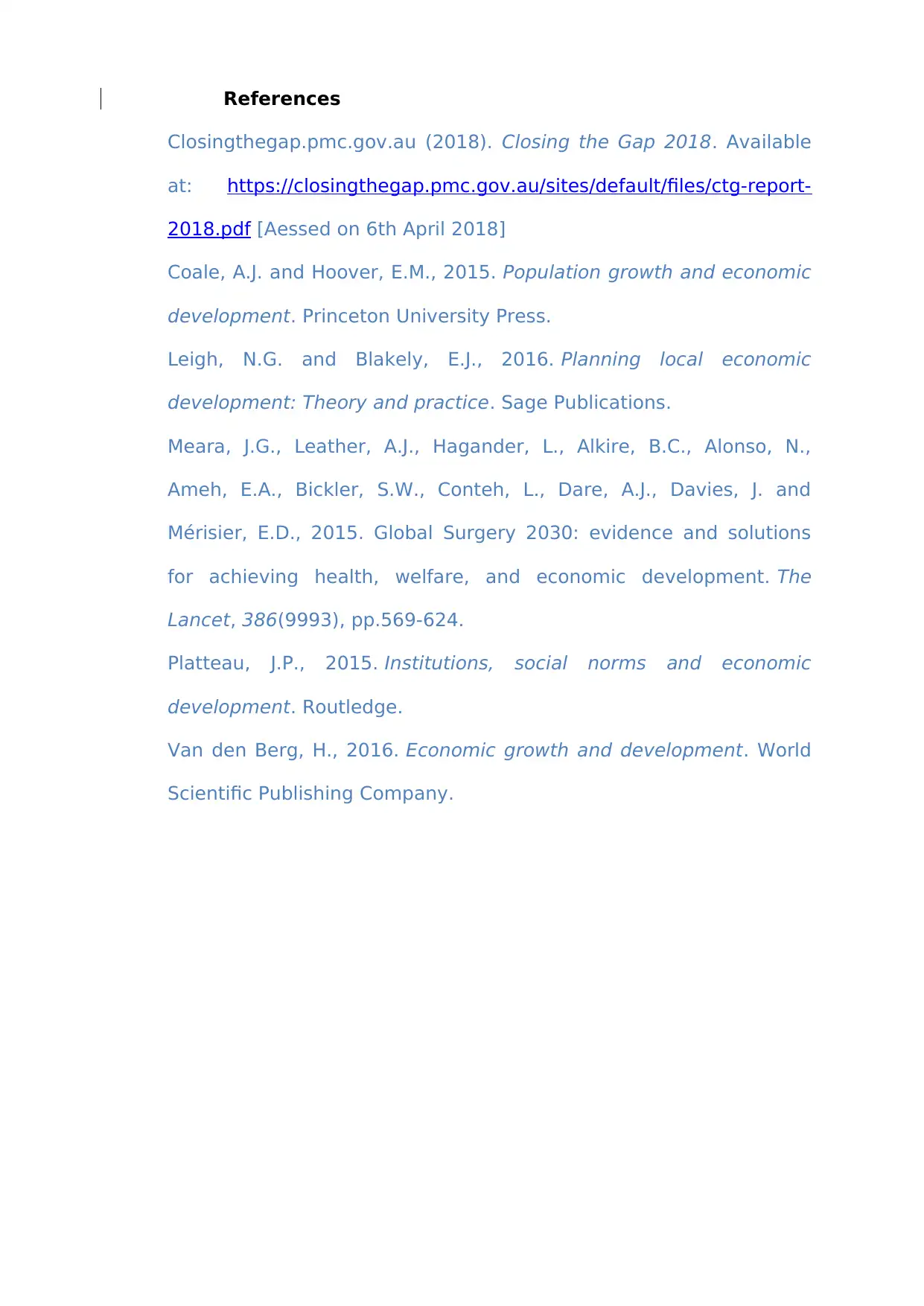
References
Closingthegap.pmc.gov.au (2018). Closing the Gap 2018. Available
at: https://closingthegap.pmc.gov.au/sites/default/files/ctg-report-
2018.pdf [Aessed on 6th April 2018]
Coale, A.J. and Hoover, E.M., 2015. Population growth and economic
development. Princeton University Press.
Leigh, N.G. and Blakely, E.J., 2016. Planning local economic
development: Theory and practice. Sage Publications.
Meara, J.G., Leather, A.J., Hagander, L., Alkire, B.C., Alonso, N.,
Ameh, E.A., Bickler, S.W., Conteh, L., Dare, A.J., Davies, J. and
Mérisier, E.D., 2015. Global Surgery 2030: evidence and solutions
for achieving health, welfare, and economic development. The
Lancet, 386(9993), pp.569-624.
Platteau, J.P., 2015. Institutions, social norms and economic
development. Routledge.
Van den Berg, H., 2016. Economic growth and development. World
Scientific Publishing Company.
Closingthegap.pmc.gov.au (2018). Closing the Gap 2018. Available
at: https://closingthegap.pmc.gov.au/sites/default/files/ctg-report-
2018.pdf [Aessed on 6th April 2018]
Coale, A.J. and Hoover, E.M., 2015. Population growth and economic
development. Princeton University Press.
Leigh, N.G. and Blakely, E.J., 2016. Planning local economic
development: Theory and practice. Sage Publications.
Meara, J.G., Leather, A.J., Hagander, L., Alkire, B.C., Alonso, N.,
Ameh, E.A., Bickler, S.W., Conteh, L., Dare, A.J., Davies, J. and
Mérisier, E.D., 2015. Global Surgery 2030: evidence and solutions
for achieving health, welfare, and economic development. The
Lancet, 386(9993), pp.569-624.
Platteau, J.P., 2015. Institutions, social norms and economic
development. Routledge.
Van den Berg, H., 2016. Economic growth and development. World
Scientific Publishing Company.
⊘ This is a preview!⊘
Do you want full access?
Subscribe today to unlock all pages.

Trusted by 1+ million students worldwide
1 out of 6
Your All-in-One AI-Powered Toolkit for Academic Success.
+13062052269
info@desklib.com
Available 24*7 on WhatsApp / Email
![[object Object]](/_next/static/media/star-bottom.7253800d.svg)
Unlock your academic potential
Copyright © 2020–2025 A2Z Services. All Rights Reserved. Developed and managed by ZUCOL.